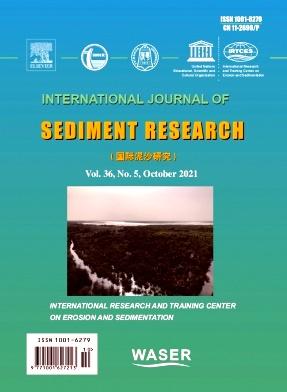Effect of submerged vegetation on hydraulic resistance of ice-covered flows
IF 3.5
2区 环境科学与生态学
Q2 ENVIRONMENTAL SCIENCES
引用次数: 0
Abstract
Understanding the hydraulic resistance is vital for river engineering projects that include the installation of in-stream infrastructure, such as bridge abutments, which directly impact flow dynamics and sediment transport. In this study, based on laboratory experiments in a large-scale flume, the hydraulic resistance of flow has been investigated, considering the combined effects of submerged vegetation, ice cover, and bed sediment. The bed and ice cover shear stress, vegetative drag, and the composite Manning's roughness coefficient under various conditions have been calculated and discussed. An empirical model that indicates the relationship between the composite Manning's roughness coefficient of the channel and the roughness coefficients of the bed, ice cover, and vegetation has been developed. Results indicated that the presence of an ice cover leads to a noticeable increase in the channel bed shear stress, with a greater contribution of the shear stress in vegetated beds under ice-covered flow conditions, accounting for up to 60% of the total shear stress compared to that under open flow conditions with vegetated beds. Compared to the square arrangement of vegetation elements in the bed, the presence of vegetation arranged in a staggered pattern in the bed results in a decrease in the bed shear stress but an increase in the vegetation drag force. Findings emphasize the importance of vegetation density as the primary factor influencing the drag coefficient. Notably, the drag force exceeds the shear force in all experimental scenarios, accounting for 85% of the total resistance force. Furthermore, Manning's roughness coefficient for the vegetation patch exhibits higher values than that for the ice cover. A clear correlation exists between Manning's coefficients and the Froude number; the higher the flow Froude number, the less the Manning's roughness coefficient.
淹没植被对覆冰水流水力阻力的影响
了解水力阻力对河流工程项目至关重要,包括安装河流内基础设施,如桥台,直接影响水流动力学和泥沙运输。本研究在大型水槽室内试验的基础上,考虑水下植被、冰盖和河床沉积物的综合影响,对水流的水力阻力进行了研究。计算并讨论了不同条件下床和冰盖的剪应力、营养阻力和复合曼宁粗糙度系数。建立了河道复合曼宁粗糙度系数与河床、冰盖和植被粗糙度系数之间关系的经验模型。结果表明,冰盖的存在导致河床剪切应力的显著增大,其中覆盖冰流条件下植被河床的剪切应力的贡献更大,占总剪切应力的60%,而开放流条件下植被河床的剪切应力占比最大。与床层中植被要素呈方形排列相比,交错排列的植被在床层中的存在使床层剪应力减小,但使植被阻力增大。研究结果强调了植被密度作为影响阻力系数的主要因素的重要性。值得注意的是,在所有的实验场景中,阻力都大于剪切力,占总阻力的85%。此外,植被斑块的Manning粗糙度系数高于冰盖的Manning粗糙度系数。曼宁系数和弗劳德数之间存在明显的相关性;流量弗劳德数越高,曼宁粗糙度系数越小。
本文章由计算机程序翻译,如有差异,请以英文原文为准。
求助全文
约1分钟内获得全文
求助全文
来源期刊
CiteScore
6.90
自引率
5.60%
发文量
88
审稿时长
74 days
期刊介绍:
International Journal of Sediment Research, the Official Journal of The International Research and Training Center on Erosion and Sedimentation and The World Association for Sedimentation and Erosion Research, publishes scientific and technical papers on all aspects of erosion and sedimentation interpreted in its widest sense.
The subject matter is to include not only the mechanics of sediment transport and fluvial processes, but also what is related to geography, geomorphology, soil erosion, watershed management, sedimentology, environmental and ecological impacts of sedimentation, social and economical effects of sedimentation and its assessment, etc. Special attention is paid to engineering problems related to sedimentation and erosion.

 求助内容:
求助内容: 应助结果提醒方式:
应助结果提醒方式:


